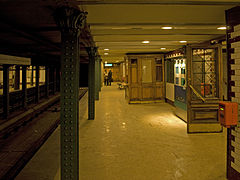| Kodály körönd | |||||||||||
|---|---|---|---|---|---|---|---|---|---|---|---|
| Budapest Metro station | |||||||||||
 Station entrance Station entrance | |||||||||||
| General information | |||||||||||
| Location | Kodály körönd, Budapest Hungary | ||||||||||
| Coordinates | 47°30′34″N 19°04′12″E / 47.5094°N 19.07°E / 47.5094; 19.07 | ||||||||||
| Platforms | 2 side platforms | ||||||||||
| Construction | |||||||||||
| Structure type | cut-and-cover underground | ||||||||||
| History | |||||||||||
| Opened | 2 May 1896 | ||||||||||
| Services | |||||||||||
| |||||||||||
Kodály körönd is a station of the yellow M1 (Millennium Underground) line of the Budapest Metro, under Kodály circus on Andrássy Avenue. Like the circus, the metro station takes its name from Zoltán Kodály who once lived in one of the buildings on the circus.
The station was opened on 2 May 1896 as part of the inaugural section of the Budapest Metro, between Vörösmarty tér and Széchenyi fürdő. This section, known as the Millennium Underground Railway, was the first metro system in continental Europe. In 2002, it was included into the World Heritage Site "Budapest, including the Banks of the Danube, the Buda Castle Quarter and Andrássy Avenue".
The station has two side platforms, each with its own access from the street.
Connection
- Bus: 105, 210, 210B
References
- Schwandl, Robert. "Budapest". urbanrail.
- "Budapest, including the Banks of the Danube, the Buda Castle Quarter and Andrássy Avenue". UNESCO.
| Budapest Metro | ||
|---|---|---|
 | ||
This Budapest Metro-related article is a stub. You can help Misplaced Pages by expanding it. |
This article about a Hungarian railway station is a stub. You can help Misplaced Pages by expanding it. |



